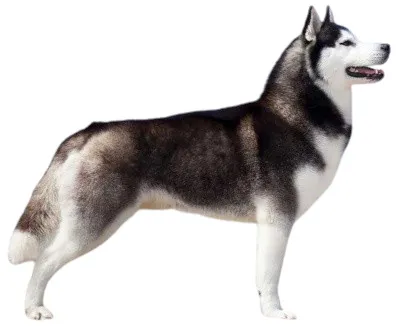
The Siberian Husky is a sled dog breed originating from northeastern Siberia. Historically used by the Chukchi people to pull sleds over long distances in extreme climates, this dog is renowned for its endurance, intelligence, and ability to work in a team. It is a pack dog with high energy and a friendly temperament.
The Siberian Husky is a medium-sized dog, typically measuring between 50 and 60 cm at the shoulder. It has a graceful and athletic appearance, with a compact and well-proportioned body. Its almond-shaped eyes, often blue or brown, give it an expressive and piercing look. Its ears are upright and triangular, set high on its head.
The Siberian Husky has a double coat, with a dense undercoat and straight, thick outer fur. This coat protects it from the intense cold of Arctic regions, but also provides insulation against heat. It comes in a variety of colors, from black to pure white, with shades of gray and red in between.
Males measure between 54 and 60 cm at the shoulder, while females are slightly smaller, measuring between 50 and 56 cm. Their weight ranges from 20 to 27 kg for males, and from 16 to 23 kg for females. The Husky is a sturdy dog, capable of covering long distances at a moderate speed.
The Siberian Husky is an energetic, independent, and friendly dog. Although it can be stubborn at times, it is generally sociable and affectionate toward humans. It gets along well with other dogs but has a strong prey drive, which can pose challenges with smaller animals. Its pack mentality makes it ill-suited for solitude, and it requires plenty of exercise and interaction to stay happy.
The Siberian Husky is a robust breed, but it can be prone to health issues such as hip dysplasia, cataracts, and certain skin conditions. It is important to provide it with a balanced diet and regular exercise to maintain its physical and mental well-being. Regular veterinary check-ups are also recommended to prevent any potential health problems.

The Siberian Husky Puppy is a medium-sized dog, famous for its wolf-like appearance and often blue or heterochromatic eyes. Originating from Siberia, it is specially adapted to cold climates thanks to its double, dense, and insulating coat. The Husky is an energetic, social, and friendly dog that gets along well with children and other animals. It is intelligent and independent but can be a bit stubborn, requiring consistent and firm training. This dog needs plenty of exercise and loves to run, making it an excellent companion for active people and outdoor enthusiasts.
The price of a Siberian Husky Puppy varies depending on the breeder and pedigree. On average, you should expect a budget of around 1,200 euros.
The Siberian Husky is an energetic and independent sled dog, known for its intelligence but also its legendary stubbornness. Its training requires a specific approach adapted to its Nordic dog temperament.
Siberian Husky specifics: This dog has a strong pack instinct and intense need for activity. Very sociable, it can however be prone to escaping and difficult to recall once on the move.
Early socialization: Start at 8 weeks to acclimate it to different environments, people and animals. This very sociable dog must learn to manage its excitement.
Positive training: Reward-based methods (treats, games) work well. Avoid punishments that could make it resistant or wary.
Intensive exercise: Plan at least 2 hours of daily physical activity (canicross, biking, long hikes) to channel its overflowing energy.
Essential containment: A very high fenced yard (2m minimum) is mandatory, as is the leash during walks - its hunting and escape instincts are highly developed.